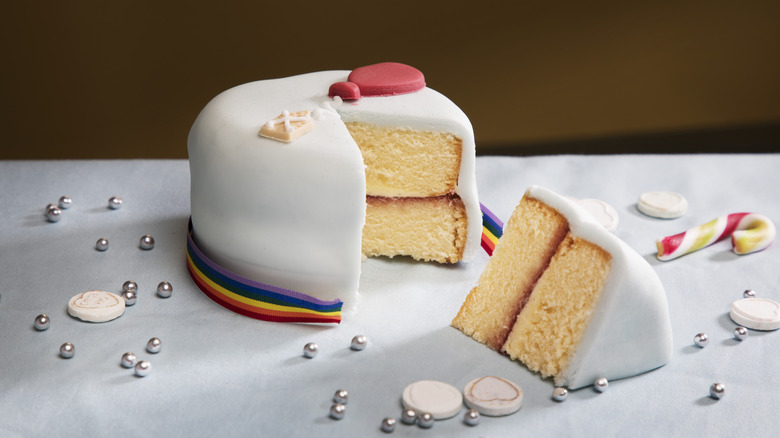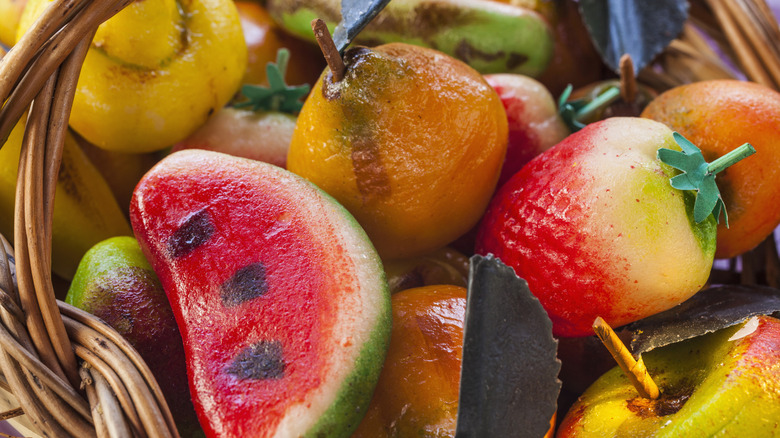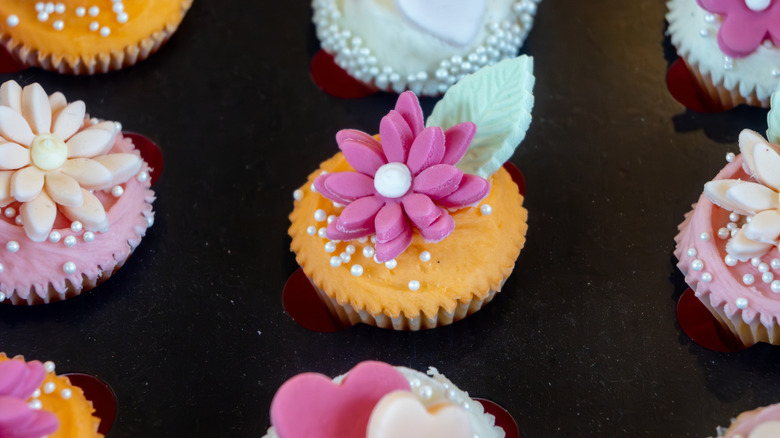What's The Difference Between Marzipan And Fondant?
Have you ever wondered what pastry chefs use to make such ornate decorations? Or how they make almost lifelike cake toppers that are obviously made from something other than frosting? Naturally, bakers have all manner of tools in their belt, and two of the most common for decorating are marzipan and fondant. Whether creating a base layer of color or sculpting a bust of a happy couple on their wedding day, marzipan and fondant can be used to add dimension to pastries — but only if you know what each of them does.
Both marzipan and fondant have a malleable consistency that lends themselves to various baking techniques. You can roll them out into a thin sheet to cover a cake and make a smooth surface, making them an ideal alternative to a messy layer of icing. Their pliable texture also means you can fold drops of colored dye into them like frosting. The only difference is a more solid decoration to work with unlike frosting that to melt or mush. Yet, while they have similar functions, it's important to know how marzipan and fondant differ. The main things to consider are their different tastes, due to their main ingredients and textures which, although more similar than frosting, make them better suited for different baking needs. So, quit trying to upgrade your canned frosting and get to know these baking staples for true mastery in the kitchen.
What is marzipan?
The origins of marzipan are dubious, with countries all over Europe and the Middle East claiming to be the creators. Yet one thing is for certain, this almond-based delight is a staple in the pastry world. Made from a ground almond paste, water, and sugar, marzipan has a consistency resembling clay that you can bake into sturdy shapes. Its texture tends to stay tacky and pliable which makes it easy to mold into little figurines. Note that marzipan can indeed be colored and often features rich hues such as reds and greens like in the delicious Italian cake, Cassata Siciliana. But, because of the natural coloring of almonds, you can never have pure white marzipan.
Since marzipan has such a rich history of different cultures using different shapes to give as gifts or desserts on holidays, you can often find premade decorations in stores. However, it is possible to make your own marzipan at home to have as a treat or to use for decorations. First, you'll need to learn how to remove the skins from your almonds to use as a paste and mix them with the other ingredients for the right consistency. Once your base is made you're free to shape, color, and bake your marzipan as desired — or roll it into a tube to store and eat in slices — and enjoy. Unlike fondant, this confection doesn't need to be accompanied to be delicious and is a great way to enjoy different cultures and upgrade your cake game all at once.
What is fondant?
Fondant is icing's more solid cousin; a malleable 'dough' made of powdered sugar, corn syrup, and water. Its taste is exceedingly sweet and only be served on baked goods. So, while a layer of rolled fondant might be an acceptable sugary addition, you likely won't be biting into a fondant figurine the way you would marzipan. Yet, fondant's smooth and sweet makeup allows it to be handled more delicately and used in ways marzipan can't.
Fondant doesn't need to be baked like marzipan, meaning it stays pliable for much longer is ideal for ornate decorations. Note that fondant can crack when it becomes too dry, so it's best to keep it covered when storing and keep water on hand when working with it. The other advantage of fondant is the range of colors that can be applied to it, including plain white. This makes it much more popular for sculptures like flowers or lifelike busts that require a smoother material and a lighter touch. While fondant may not be as popular to enjoy as a snack, it certainly adds sophistication and class to your baking with its sleek look and infinite possibilities. And now that you know how fondant differs from marzipan, you can take your cakes to the next level without the hassle of store-bought sprinkles and icing.



